Review Date: June 17, 2013
Category: Beginner to Serious Amateur
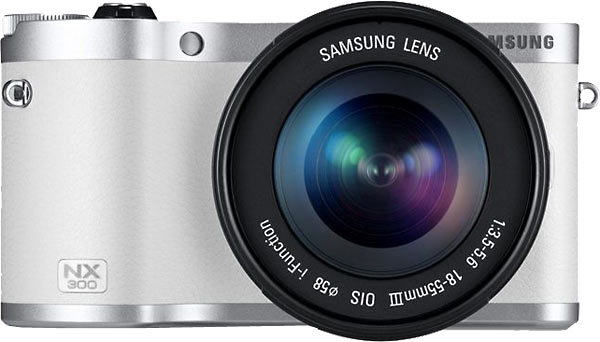

Photoxels Gold Award – Interchangeable Lens Camera
HANDLING & FEEL
The Samsung NX300 features a larger, more comfortable handgrip and beautiful textured surfaces. The construction is a combination of magnesium alloy and plastic so that the camera feels solid without being heavy. The build quality is very good.
As with any Interchangeable Lens Camera, holding the NX300 is a two-handed affair. The best way to hold and carry the NX300 safely is with your left hand under the camera and around the lens barrel.

The front of the camera is beautifully sparse: An AF-assist light/Timer lamp on the left side of the lens and the Lens removal button on the right side.
The 18-55mm (27-84mm equiv.) F3.5-5.6 III OIS portrait kit lens is included with my review camera. It has a manual zoom ring as well as a manual fly-by-wire focus ring. Turn the focus ring and the screen display enlarges for a better view if MF Assist is turned to ON [MENU – Camera – MF ASSIST – Enlarge x5 or x8]. It’s by far the best fly-by-wire AF yet, with the focus ring perfectly synched to the focus so that it almost feels like you are using a mechanical focus ring. Turn Focus Peaking on and you can easily focus on any part on the scene. The kit lens is optically image stabilized.
Samsung is standardizing the Lens Priority mode (aka, i-Function or iFn) on all their new lenses and this kit lens has this feature. There’s a button on the lens barrel labeled iFn. This button acts, as its name implies, like a Function button: press it and a Quick Menu appears on screen. You can then use the lens focus ring (and/or Jog Dial) to set an exposure setting depending on what shooting mode you’re in. The purpose for the Lens Priority mode is to allow the photographer to select an exposure without having to reach for a control button: you can leave your index finger on the Shutter Release button while your left hand makes the exposure selection.
There is an AF/MF button to switch the lens to manual focus on the 18-55 lens. Since the zoom is manual, you can zoom as slow or fast as you wish and zoom during movie recording. There will be a lsight zoom noise of the zoom ring turning but, depending on the ambient noise, you may not notice it. In addition, you can pause a movie recording by pressing OK, recompose to a new scene and then press OK to seamlessly continue the recording on the same clip. Great for those special effects where someone appears and disappears as if by magic with a wave of the hand. If you set the lens to MF, you can manually control the focus during movie recording.
The NX300 also uses an image sensor with a hybrid Phase Detection & Contrast AF with 105 Phase Detection
AF points and 247 Contrast AF points. Which probably explains why AF is so fast.
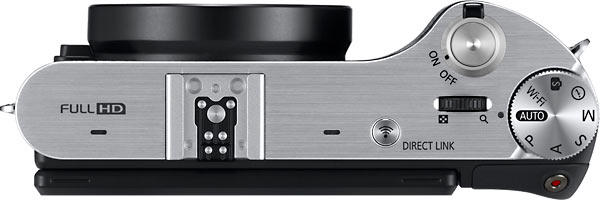
The top of the camera has, from right to left, the Shooting Mode dial, the Shutter Release Button, the Power ON/OFF switch around the shutter release button, the Jog Dial, the Direct Link button, the Hot Shoe, and the Stereo Microphone (two holes, one on either side of the Hot Shoe).
The Shooting Mode Dial has Smart AUTO, PASM, iFn (Lens Priority Mode), Smart (Scene modes), Wi-Fi. The Mode Dial can be conveniently and freely rotated in any direction with your thumb and is stiff enough that it will not be easily moved out of its current selection. Note that there is no Movie mode on the Mode Dial; just press the dedicated Movie button to start recording a video.
The Jog Dial allows you to navigate options in MENU, to resize the AF frame and to select a setting when you press the Fn key (which brings up the Smart Panel). It also allows you to select exposure settings in the various shooting modes (customizable). In Program mode, it allows program shift. In Shutter-Priority and Manual modes, it selects a shutter speed. In Aperture Priority mode, it selects an aperture. In PAS modes, you can also dial in an exposure compensation when the EV button is held pressed in and the Jog Dial rotated. In Manual mode, it selects a shutter speed; holding down the Exposure Compensation button and rotating the Jog Dial changes the aperture.
Set the iFn feature to change aperture in Manual mode [Menu – Custom – iFn Customizing – Aperture]. Now, in Manual mode you don’t have to arkwardly hold down the Exposure compensation button and scroll the Jog Dial to set an aperture. Instead, simply press the iFn button on the lens to bring up the aperture and rotate the manual focus ring to select an aperture.)
| Shooting Mode | Jog Dial | iFn on Lens + Focus Ring |
|---|---|---|
| P | Program Shift | EV / ISO/ WB / iZOOM |
| A | Aperture | Aperture / EV / ISO/ WB / iZOOM |
| S | Shutter Speed | Shutter Speed / EV / ISO/ WB / iZOOM |
| M | Shutter Speed | Aperture / Shutter Speed / ISO/ WB / iZOOM |
Shown above are the iFn choices available. You can customize what choices show up when you press the iFN button [Menu – Custom – iFn Customizing]. You keep pressing the iFn button to rotate thru the available choices.
Here is how I customized mine:
| Shooting Mode | Jog Dial | iFn on Lens + Focus Ring |
|---|---|---|
| P | Program Shift | EV |
| A | Aperture | Aperture / EV |
| S | Shutter Speed | EV |
| M | Shutter Speed | Aperture / EV |
Do not confuse the iFn on the lens with the i (Lens Priority) mode on the Mode Dial. The latter is a Depth of Field function that allows you to adjust the depth of field so as to blur or sharpen the background. Once you set the shooting mode to Lens Priority, press the iFN button on the lens to activate it. You can then turn the focus ring to actually adjust the aperture to achieve the desired depth of field effect.You can also press the iFN button on the lens again to toggle to iZoom allowing you to magnify the image on screen by a factor of up to 2x.
The Direct Link button can be customized to turn on a Wi-Fi feature [Menu – Custom – Key Mapping – DIRECT LINK – select from AutoShare, MobileLink, Remote Viewfinder, Auto Backup, Email, SNS & Cloud, AllShare Play].
The NX300 does not have a built-in flash. The compact SEF8A flash is a small external flash that is included in the box but unfortunately it cannot be tilted upward for bounce flash, sorely limiting its usefulness. Other available flash units are: the larger SEF20A (which does enable bounce shooting) and speedlight SEF42A.
When Sensor Cleaning is enabled at Start-Up, startup time is a long 3 sec. (from Power ON to LCD ready for capture, i.e. time-to-first-shot). Shot to shot times is about 1 sec. (@ 10 shots in 10 sec. in M mode, 1/125sec.).
TIP: Disable Sensor Cleaning at Start-Up [Menu – Setup- Sensor Cleaning – Start-Up Action – Off ] and see the startup time go down to a fast 1 sec. Do remember to manually run sensor cleaning from time to time (and everytime you change lens) to ensure no dust particles have entered the camera and found its way onto the image sensor.
In good lighting, there is no practical shutter lag and AF is fast and precise. In low lighting, AF is about 1 sec. and locks precisely. I like and find Selection AF to be really useful; it uses the OK Button and Navigation Buttons (or your finger if Touch AF is turned on) to quickly position the (resizable using the Jog Dial) AF Frame at 19 x 13 = 247 AF points (at the smallest AF Frame size), almost to the very edges of the screen. To quickly reposition the AF frame to the centre position, simply touch the screen at that position.
TIP: If you like to use Selection AF as I do, don’t forget to link AE to AF [Menu – Camera – Link AE to AF Point – On] which will tell the meter to take its reading wherever you’ve moved the AF Frame to. The reasoning being that you probably want the area under focus to also be correctly exposed. I find this really useful for macro photography.
You can save an image in the RAW file format. It takes about 4 sec. to write a RAW image to memory card (though you can take the next one in about 2 sec.). You can also select to save a RAW+JPEG (Super Fine, Fine or Normal).
At Picture Size = Super Fine, a 20.3MP JPEG image is compressed down to anywhere between 3MB and 10MB. A RAW image occupies about 24MB.
Included in the box is a rechargeable Li-ion battery BP1130 that can take about 330 shots or 110 min. of video (Samsung’s standard) on a fresh charge. A Travel Adapter ETAOU61JBE (with power cord) plugs into the camera’s USB port and recharges a depleted battery in camera in approx. 210 min.
The Samsung NX300 uses the SD, SDHC, SDXC and UHS-1 card (Class 6 and above recommended).
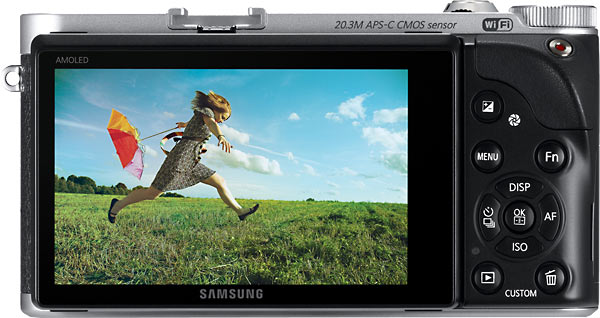
The Samsung NX300 sports a 3.3-in. tiltable AMOLED Touch Panel display with a high 768k-dot resolution. The AMOLED has a fast enough refresh rate for a smooth display. The monitor’s brightness can be adjusted in MENU. The screen gains up well in low-light. The display is bright and clear enough for quite precise manual focusing, and the display info layout is one of the best I’ve used.
All the controls are to the right side of the AMOLED: dedicated Movie button, EV button, Menu, Fn, Navigation button (4-Way Controller), OK button, Playback and Delete/Custom button. Samsung, unlike many camera manufacturers, seems to have perfected the size and placement of buttons and dials.
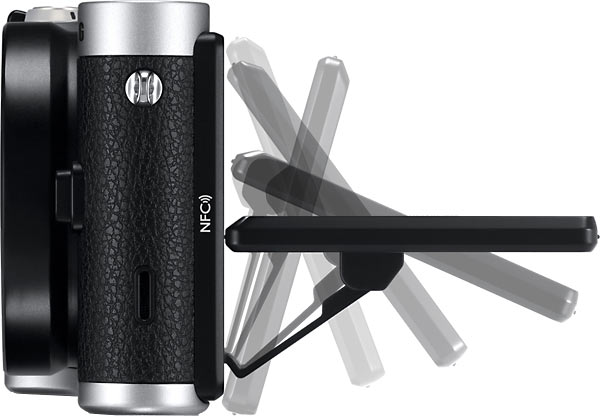
The Fn button displays a very convenient Smart Panel (Super Control Panel). What I especially like about the Smart Panel is that you simply select the setting you want to change, scroll the Jog Dial and it’s set; no need to confirm with an extra and redundant OK. The OK button brings up AF Area in shooting mode. The Navigation Button has UP = Disp, RIGHT = AF mode, DOWN = ISO, LEFT = Drive/Self-timer.
The Delete button allows you to delete one or multiple images in Playback mode. To delete all images, you need to access the Playback Menu. You can customize the Delete button in shooting mode to: Optical Preview, One Touch WB, One Touch RAW+, Reset (to quickly reset some settings), AEL, AEL Hold.
Tip: If you miss a dedicated AEL button, just customize the Delete button: [Menu – Custom – Key Mapping – Custom – select AEL or AEL Hold]
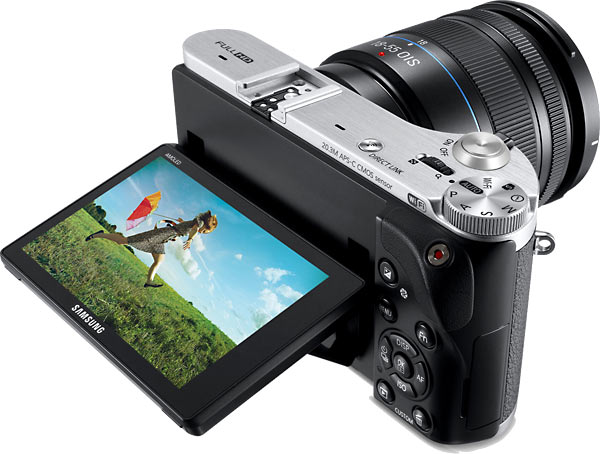
The Exposure Compensation button needs to be pressed and held down while you rotate the Jog Dial. I would rather it acts as a toggle button. You can customize the Bracket area and order [Menu – Camera – Bracket Set]. AE Bracket Set will allow you to set the exposure interval; WB Bracket Set to adjust the WB interval range; and P Wiz Bracket Set to set 3 picture wizards.
The Menu button brings up a menu structured with 4 tabs. Each tab now corresponds to one scrolling screen. The Menu is easy to understand and navigate, but you will now have to scroll down to find items.
In Continuous mode, you can shoot at about 8.6fps in JPEG or RAW.
A couple of nice features: the hinged plastic Terminal door opens up wide to allow unimpeded access to the HDMI port and USB/Shutter release port. You can optionally purchase Shutter Release SR2NX02 that plugs into the Micro USB port. The Battery/Card compartment has a latch to keep the battery from accidentally falling. The tripod socket at the bottom is metal and is centered and inline with the lens; unless you use an unusually large tripod head, you will most probably be able to change the battery or card when the camera is mounted onto a tripod.
The Samsung NX300 is a nicely built compact mirrorless DSLR with all the important functions accessible from a dial or control button. It’s that rare camera that is extremely well thought out with very good handling and build. The NX300 is quite intuitive to use and the enthusiast photographer will find lots to like in the handling and ease-of-use of the Samsung NX300.
Next: Samsung NX300 User’s Experience
Related Links:




















